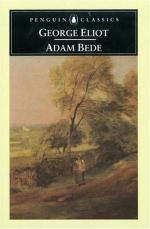Poor Seth! He was never on horseback in his life except once, when he was a little lad, and Mr. Jonathan Burge took him up behind, telling him to “hold on tight”; and instead of bursting out into wild accusing apostrophes to God and destiny, he is resolving, as he now walks homewards under the solemn starlight, to repress his sadness, to be less bent on having his own will, and to live more for others, as Dinah does.
Chapter IV
Home and Its Sorrows
A green valley with a brook running through it, full almost to overflowing with the late rains, overhung by low stooping willows. Across this brook a plank is thrown, and over this plank Adam Bede is passing with his undoubting step, followed close by Gyp with the basket; evidently making his way to the thatched house, with a stack of timber by the side of it, about twenty yards up the opposite slope.
The door of the house is open, and an elderly woman is looking out; but she is not placidly contemplating the evening sunshine; she has been watching with dim eyes the gradually enlarging speck which for the last few minutes she has been quite sure is her darling son Adam. Lisbeth Bede loves her son with the love of a woman to whom her first-born has come late in life. She is an anxious, spare, yet vigorous old woman, clean as a snowdrop. Her grey hair is turned neatly back under a pure linen cap with a black band round it; her broad chest is covered with a buff neckerchief, and below this you see a sort of short bedgown made of blue-checkered linen, tied round the waist and descending to the hips, from whence there is a considerable length of linsey-woolsey petticoat. For Lisbeth is tall, and in other points too there is a strong likeness between her and her son Adam. Her dark eyes are somewhat dim now—perhaps from too much crying—but her broadly marked eyebrows are still black, her teeth are sound, and as she stands knitting rapidly and unconsciously with her work-hardened hands, she has as firmly upright an attitude as when she is carrying a pail of water on her head from the spring. There is the same type of frame and the same keen activity of temperament in mother and son, but it was not from her that Adam got his well-filled brow and his expression of large-hearted intelligence.
Family likeness has often a deep sadness in it. Nature, that great tragic dramatist, knits us together by bone and muscle, and divides us by the subtler web of our brains; blends yearning and repulsion; and ties us by our heart-strings to the beings that jar us at every movement. We hear a voice with the very cadence of our own uttering the thoughts we despise; we see eyes—ah, so like our mother’s!—averted from us in cold alienation; and our last darling child startles us with the air and gestures of the sister we parted from in bitterness long years ago. The father to whom we owe our best heritage—the mechanical instinct, the keen sensibility to harmony, the unconscious skill of the modelling hand—galls us and puts us to shame by his daily errors; the long-lost mother, whose face we begin to see in the glass as our own wrinkles come, once fretted our young souls with her anxious humours and irrational persistence.




